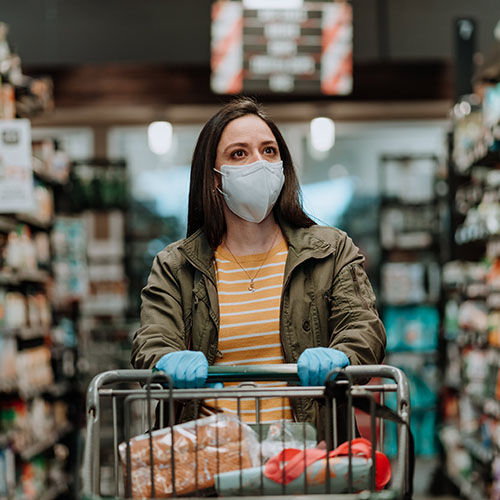Author: Simon Fraser, Vice President, Customer Experience Strategy, InMoment
2020 has, to put it politely, not been a kind year. Numerous world events, especially the COVID-19 pandemic, have put a tailspin on the term normalcy that will likely persist well into 2021. The Coronavirus has rendered many facets of everyday life unrecognisable, none more so than customer-brand interactions. Activities that many customers took for granted—eating out, going to concerts, world travel—are now the subject of fierce nostalgia. All of these developments prompt one question:
What is the state of experience right now, and where might it go from here?
I asked questions similar to these roughly seven months ago, and I feel that 2021’s doorstep is an ideal place to take stock and assess how we as experience professionals have adapted to this new normal. Moreover, I believe it’s prudent to discuss what might be awaiting us, and the experience paradigm, moving forward.
How COVID Changed Customer Experience
Let’s start with the customer behaviour trends I saw start to grow at the outset of this pandemic. Contactless payments, already on the rise thanks to global society’s ever-increasing digitisation, have only accelerated as wary customers look to protect themselves from COVID however they can. Major brands like Amazon have sustained initiatives that reduce customer-employee contact wherever possible. Finally, to no one’s great surprise, online transactions have skyrocketed, though this hasn’t necessarily produced an uptick in customer satisfaction.
In addition to these trends, which have only strengthened as this crisis has worn on, we’re witnessing the rise of what I term “the homebody economy.” Here in the UK, for example, the number of train commuters has declined significantly with little sign of short-term recovery. Consumers the world over, having been stuck at home for months now, are seeing personal norms and habits merged and jumbled up into a “time soup” as we wait for an end to the pandemic. Many of these individuals have also lost their jobs, with the British retail sector alone shedding over 125,000 jobs over the course of this year.
These trends are causing customer behaviour to shift in fundamental ways, and it’s imperative that brands across all industries pay close attention. I noted at the start of this crisis that customer demand for goods, services, and housing have all fallen as many people face being furloughed or unemployed. That lukewarm demand has, unfortunately, held steady in the months since my initial report. As the pandemic stretches into 2021, many customers are combating limited income with cost-cutting subscriptions, furniture rentals and, at the extremes, by renting clothing.
How Brands Can Respond
There’s no denying that the challenges these behavioural changes present are formidable—how can brands react? Unfortunately, there are no easy answers here. Reduced demand is a much easier problem to understand than to overcome. However, this does not mean that brands should despair; it means that they must continuously adapt to new customer tastes and preferences in a changing world. Here are a few ways your brand can do the same.
For a start, as I mentioned at the top of this discussion, brands must continue to serve customers’ heightened interest in transaction choice, as Foot Locker has done by adopting Klarna as an online payment option. Interest in contactless payments is unlikely to dissipate anytime soon and will likely linger even after the pandemic concludes. Relatedly, when customers must make in-person transactions, they’ll want safety measures like wide aisle spacing for the foreseeable future. Signage and other visual reassurance that your brand is adhering to cleanliness standards is a must.
At a more fundamental level, though, this is the time for brands to think outside the technological box as much as their resources allow. Tesco, for example, is taking contactless transactions to new heights by trialing a drone delivery programme in Ireland. Developments like these underscore the reality that this is truly technology’s time, and that the brands that can innovate new, even unorthodox solutions to the current customer climate will survive this crisis.
The Way Forward
COVID is providing neither easy questions nor easy answers for any of us. There are a myriad of challenges we must face as this crisis continues. For example, how can we stymy climbing case rates without sacrificing the economic recovery that so many consumers depend on? How are our many internal biases and our fear of uncertainty playing into our reactions, as individuals and societies, to the Coronavirus? These and many other questions factor into our journey forward as brands and experience crafters.
I firmly believe that successful brands are those that anticipate shoppers’ needs through learning from and with them. That means not only continuing to rely on your experience programme to guide you through these choppy waters, but also ensuring that it’s built around the customers and employees who sustain your organisation. Continue listening to customers, invest in long-term relationships with those individuals, and accommodate employee concerns wherever possible. Work toward innovative technological solutions as resources allow.
Finally, please bear in mind that none of these measures and strategies should be seen as temporary. This pandemic will one day be a thing of the past, but it will also have permanently changed the world by the time the virus is contained. Thus, the tactics I’ve outlined should be seen not as a stopgap measure before an imagined return to normalcy, but the foundational building blocks for what the world will be when we can embrace it again.
You can download the full PoV as a PDF by clicking the button below!
Download


